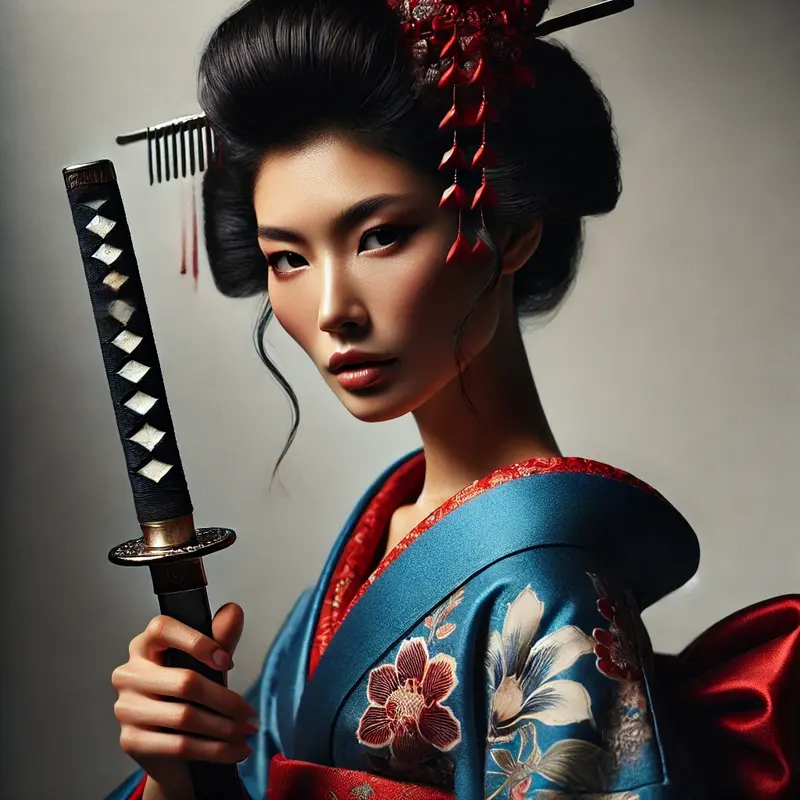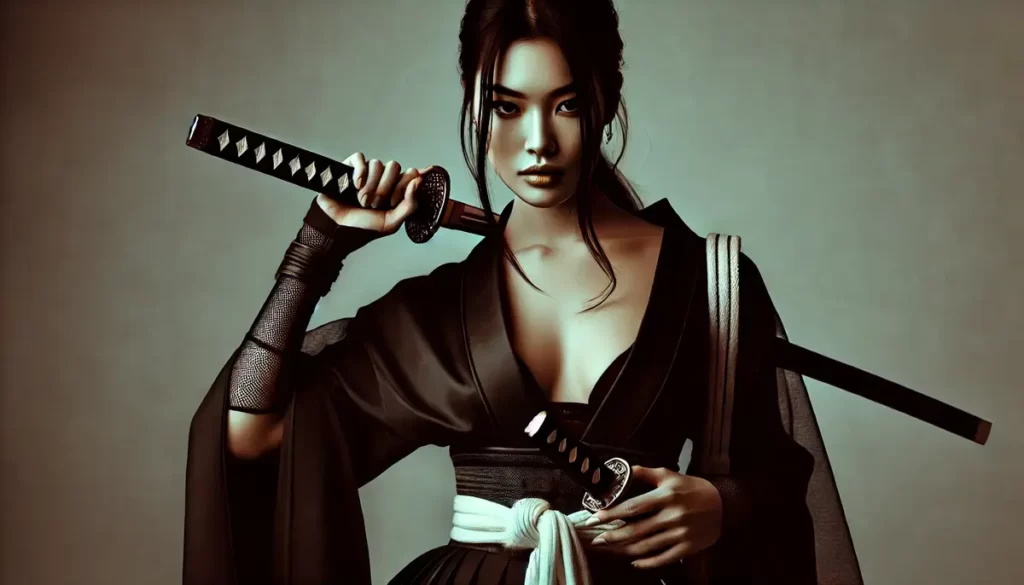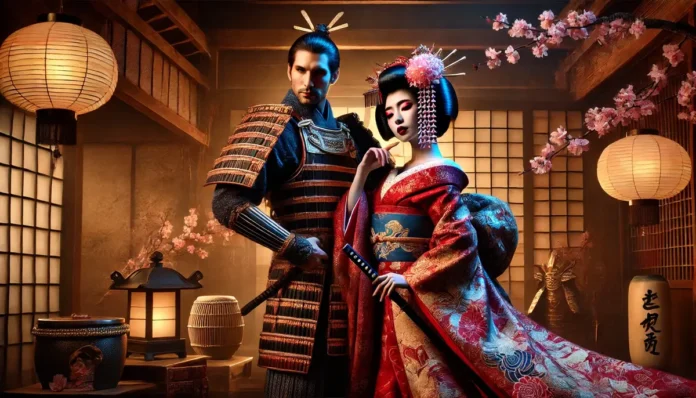The relationship between Geisha and Samurai is one of the most fascinating aspects of Japanese history, reflecting a dynamic interplay of art, culture, and societal roles.
While their functions and positions in society were distinct, Geisha and Samurai often intersected within Japan’s cultural framework, particularly during the Edo period (1603–1868).
This article explores the unique ties between Geisha and Samurai, highlighting their roles in preserving Japanese traditions and their influence on each other.
Geisha and Samurai
Defining Geisha and Samurai

Geisha were professional entertainers skilled in traditional arts, such as dance, music, and conversation.
Their role was to provide sophisticated entertainment, often in exclusive settings like teahouses (ochaya).
Samurai, on the other hand, were members of Japan’s warrior class, bound by a strict code of honor called bushido.
While their primary function was to serve as warriors, Samurai also valued cultural refinement, particularly in arts like calligraphy, poetry, and tea ceremonies.
Despite their contrasting societal roles—one focused on war, the other on entertainment—Geisha and Samurai shared a deep connection through their mutual appreciation for Japanese art and tradition.
Cultural Ties Between Geisha and Samurai

The cultural ties between Geisha and Samurai reflect a unique intersection of artistry and discipline, showcasing their shared appreciation for Japanese tradition.
1. Patronage and Artistic Support
Samurai often served as patrons of Geisha, supporting their performances and artistic endeavors.
- During the Edo period, Samurai frequented entertainment districts like Kyoto’s Gion and Tokyo’s Yoshiwara, where they enjoyed the refined artistry of Geisha.
- This patronage helped Geisha flourish as artists, ensuring the preservation of traditional Japanese arts like the shamisen and Kyo-mai dance.
Example: Prominent Samurai leaders, such as daimyo (feudal lords), often invited Geisha to perform at political gatherings to create an atmosphere of elegance and diplomacy.
2. Shared Cultural Practices
Geisha and Samurai were both deeply connected to traditional Japanese cultural practices, such as tea ceremonies and poetry.
- Tea Ceremonies: Both Geisha and Samurai were trained in the art of tea ceremonies, which emphasized mindfulness, respect, and aesthetic appreciation. Geisha performed these ceremonies for Samurai patrons, blending art and hospitality.
- Poetry and Calligraphy: Samurai often exchanged poetry or composed verses inspired by Geisha performances, fostering a cultural dialogue between these two groups.
3. Diplomacy and Social Interactions
Geisha often played a subtle yet significant role in Samurai diplomacy.
- Their presence at political gatherings helped create a neutral, harmonious environment, facilitating discussions among Samurai factions.
- Geisha’s ability to navigate social nuances made them indispensable in bridging gaps between different Samurai clans during negotiations or celebrations.
Example: In feudal Japan, Geisha were sometimes invited to accompany Samurai in hanami (flower-viewing) parties, where their performances added grace and charm to these elite gatherings.
Readmore: The Evolution of Geisha: From Feudal Times to Modern Day
Challenges in Their Relationship
The connection between Geisha and Samurai was not without challenges.
- Social Restrictions: During the Edo period, Samurai were expected to adhere to strict social codes, and relationships with Geisha were often scrutinized.
- Power Imbalance: While Geisha were respected as artists, they held a lower social status than Samurai, which sometimes led to exploitation or misunderstandings.
Despite these challenges, their interactions significantly influenced Japanese culture, blending artistry with the disciplined ethos of the Samurai.
Legacy of Geisha and Samurai Ties
The relationship between Geisha and Samurai has left an enduring legacy on Japanese history and culture, highlighting their contributions to the preservation and elevation of traditional arts and societal values.
Preservation of Arts
The mutual appreciation between Geisha and Samurai for traditional Japanese arts played a vital role in safeguarding cultural practices that remain significant today.
- Geisha performances, which included Kyo-mai dances and shamisen music, were often commissioned by Samurai patrons, ensuring these art forms were passed down through generations.
- The shared dedication to the tea ceremony exemplifies how their collaboration helped maintain this intricate ritual as a cornerstone of Japanese cultural identity.
Japan people continue to value these preserved traditions, which remain integral to cultural festivals and artistic education.
Cultural Iconography
The visual and symbolic connection between Geisha and Samurai has become a defining element of Japan’s cultural heritage.
- The serene imagery of Geisha performing for Samurai in teahouses, gardens, or during political gatherings evokes a sense of elegance and harmony.
- This iconography represents the blending of artistry and discipline, encapsulating the refinement and sophistication of Edo-era society.
Modern Influence
The legacy of Geisha and Samurai ties extends into the modern era, celebrated in various forms that continue to captivate audiences worldwide.
- Cultural Festivals: Events like the Gion Matsuri showcase traditional Geisha performances, often evoking the era when Samurai were patrons of the arts.
- Historical Reenactments: Samurai-themed events frequently include portrayals of Geisha, emphasizing their historical connection.
- Popular Media: Films, novels, and documentaries often depict the dynamic between Geisha and Samurai, highlighting their intertwined roles in shaping Japan’s cultural narrative.
The enduring influence of Geisha and Samurai serves as a testament to their shared commitment to preserving Japan’s traditions.
Their relationship not only enriched the cultural landscape of their time but also continues to inspire reverence and admiration in modern society.
Conclusion
The ties between Geisha and Samurai were shaped by a shared respect for Japanese tradition and artistry, creating a relationship that went beyond entertainment or patronage.
By supporting and influencing each other, Geisha and Samurai contributed to the preservation and elevation of Japan’s cultural identity.
Their legacy serves as a testament to the harmonious blending of art and discipline, leaving an indelible mark on Japanese history.
References
- Dalby, Liza Crihfield. Geisha. Berkeley: University of California Press, 1983.
- A seminal work that explores the role of Geisha in Japanese society, including their interactions with Samurai during the Edo period.
- Downer, Lesley. Women of the Pleasure Quarters: The Secret History of the Geisha. New York: Broadway Books, 2001.
- Offers detailed insights into the historical relationship between Geisha and Samurai, highlighting their cultural and artistic ties.
- Nishiyama, Matsunosuke. Edo Culture: Daily Life and Diversions in Urban Japan, 1600–1868. Honolulu: University of Hawaii Press, 1997.
- Explores the Edo-period entertainment districts where Geisha and Samurai frequently intersected.
- Seigle, Cecilia Segawa. Yoshiwara: The Glittering World of the Japanese Courtesan. Honolulu: University of Hawaii Press, 1993.
- Examines the broader entertainment culture of Edo Japan, including the interactions between Geisha and Samurai.
- Varley, H. Paul. Japanese Culture. Honolulu: University of Hawaii Press, 2000.
- Discusses the development of Japanese traditions, emphasizing the cultural contributions of Geisha and Samurai.
- Hendry, Joy. Understanding Japanese Society. London: Routledge, 2003.
- Provides an analysis of the societal roles of Geisha and Samurai and their influence on Japanese cultural practices.
- Iwasaki, Mineko, and Rande Brown. Geisha, A Life. New York: Atria Books, 2002.
- Memoir of a renowned Geisha that touches on the historical connections between Geisha and Samurai.
- Gion Kobu Kaburenjo. The World of Geisha. Kyoto: Kyoto Tourist Information Center, 2015.
- A guide that highlights the historical and cultural significance of Geisha, including their interactions with Samurai in entertainment districts.
- Friday, Karl F. Samurai, Warfare and the State in Early Medieval Japan. New York: Routledge, 2004.
- Discusses the Samurai class and their engagement with cultural traditions, including their relationship with Geisha.
- Bennett, Andrew. “Geisha and Samurai: Icons of Japanese Tradition.” Asian Studies Review, vol. 43, no. 3, 2020, pp. 254–271.
- Scholarly article analyzing the cultural ties between Geisha and Samurai and their shared influence on Japanese history.
These references provide a comprehensive foundation for understanding the historical and cultural connections between Geisha and Samurai.








